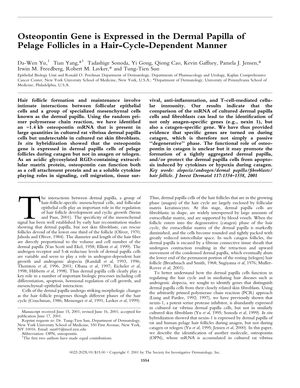Osteopontin Gene Is Expressed in the Dermal Papilla of Pelage Follicles in a Hair-Cycle-Dependent Manner
December 2001
in “
Journal of Investigative Dermatology
”

TLDR The osteopontin gene is active in a specific part of rat hair follicles during a certain hair growth phase and might affect hair cycle and diseases.
The 2001 study found that the osteopontin (OPN) gene is expressed in the dermal papilla of rat pelage follicles specifically during the catagen phase of the hair cycle, but not during the anagen or telogen phases. OPN, an extracellular matrix protein, may play a role in cell attachment, signaling, and tissue survival, and could be involved in the aggregation of dermal papilla cells or protection against apoptosis during catagen. The study also noted that androgen suppresses OPN expression, which could be relevant to hair diseases like androgenic alopecia. The research involved comparing OPN mRNA levels in cultured rat vibrissa dermal papilla cells, which were high, to those in cultured rat skin fibroblasts, where OPN mRNA was not detected. This study enhances the understanding of hair cycle regulation and the potential mechanisms underlying hair disorders.





